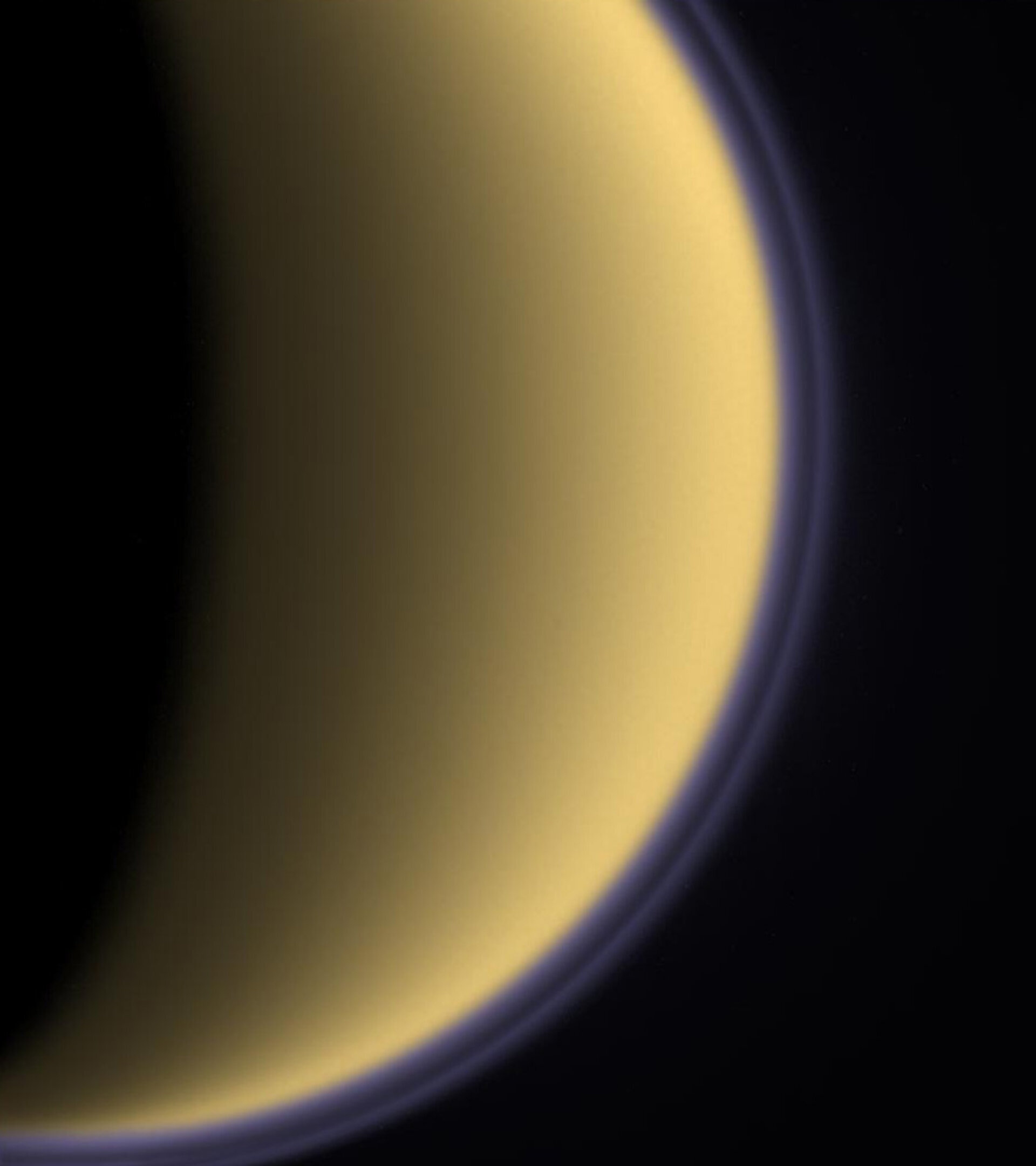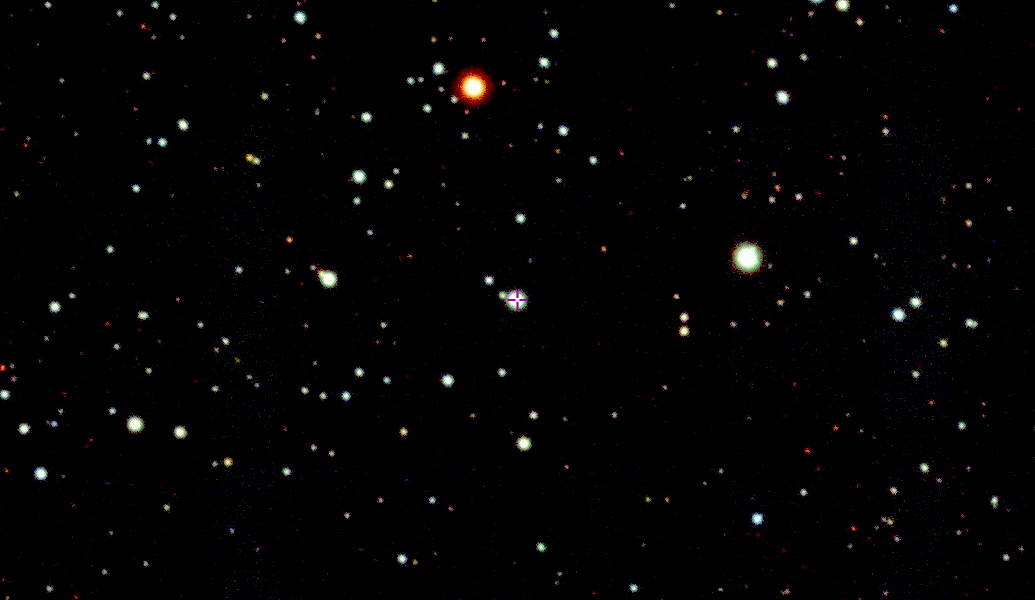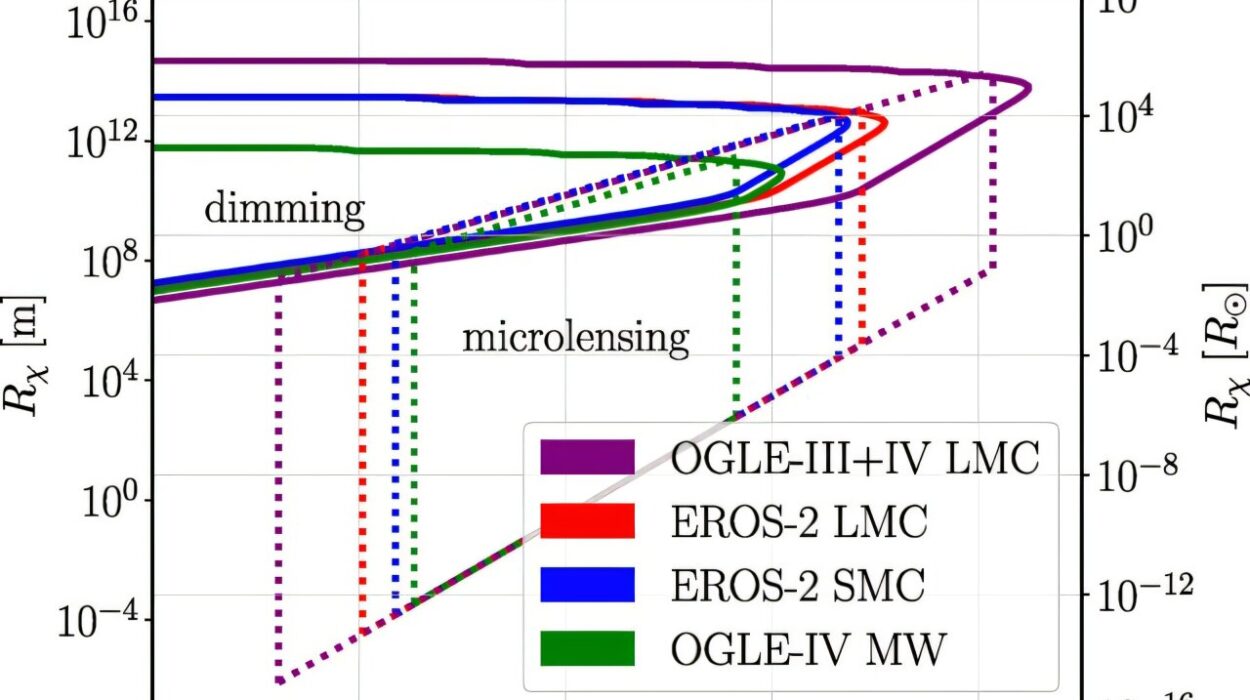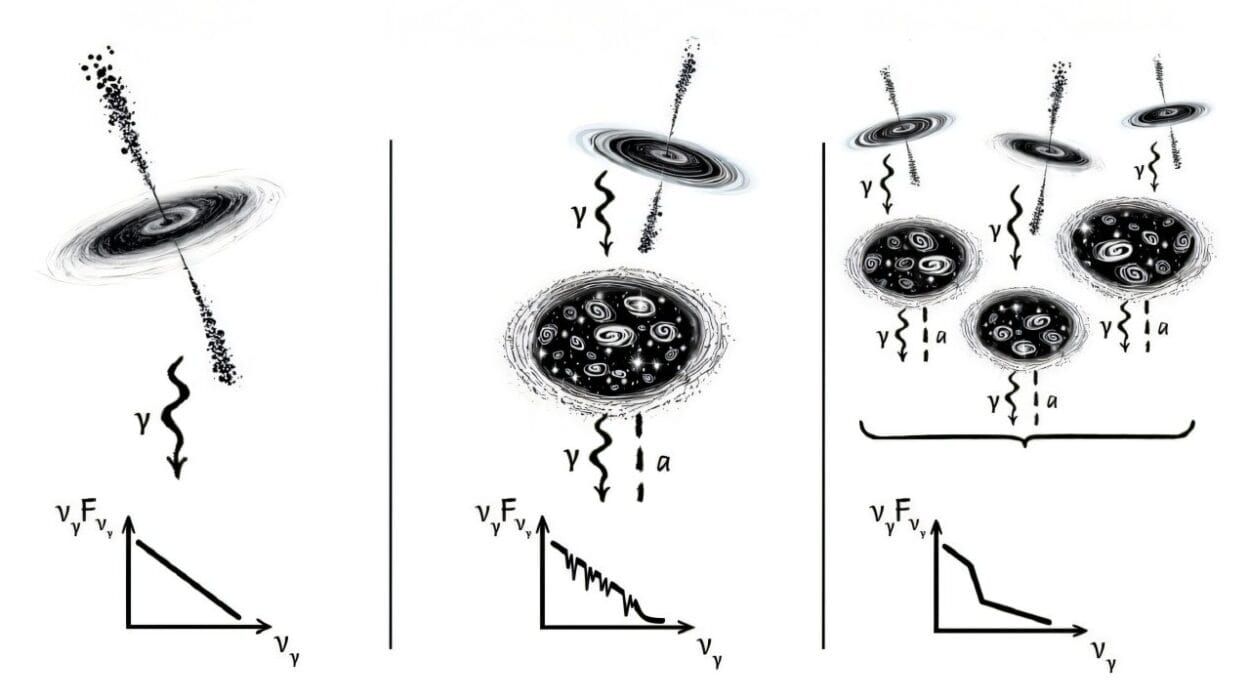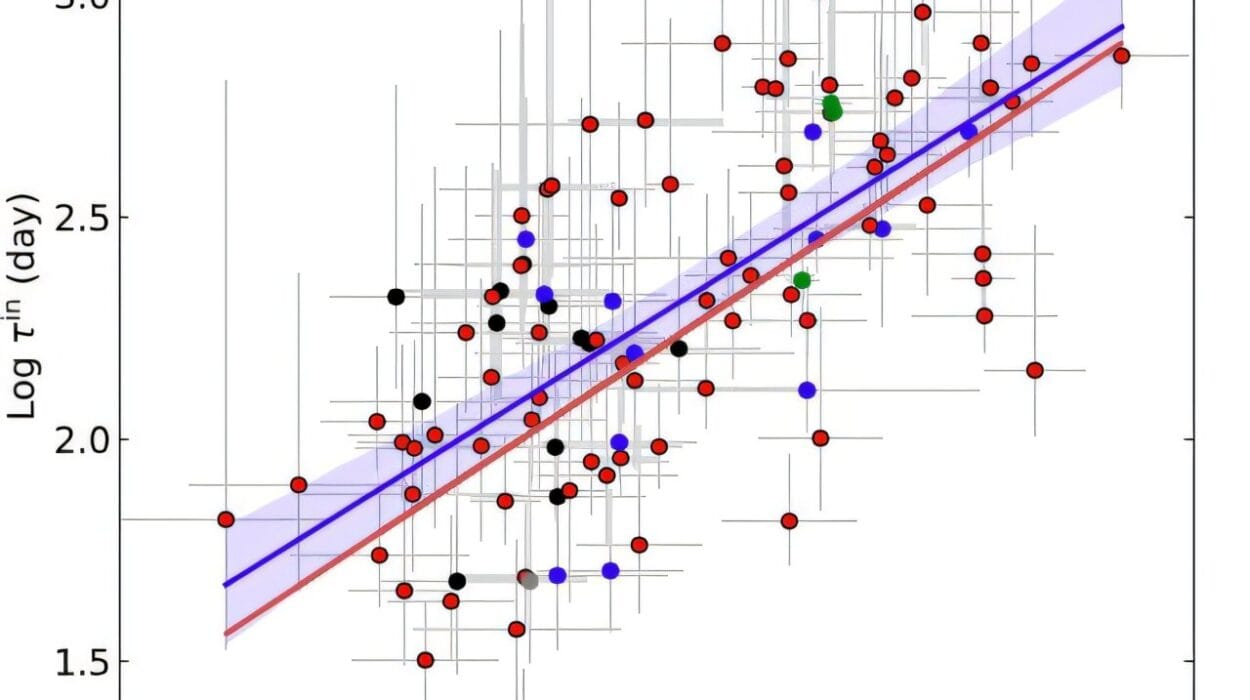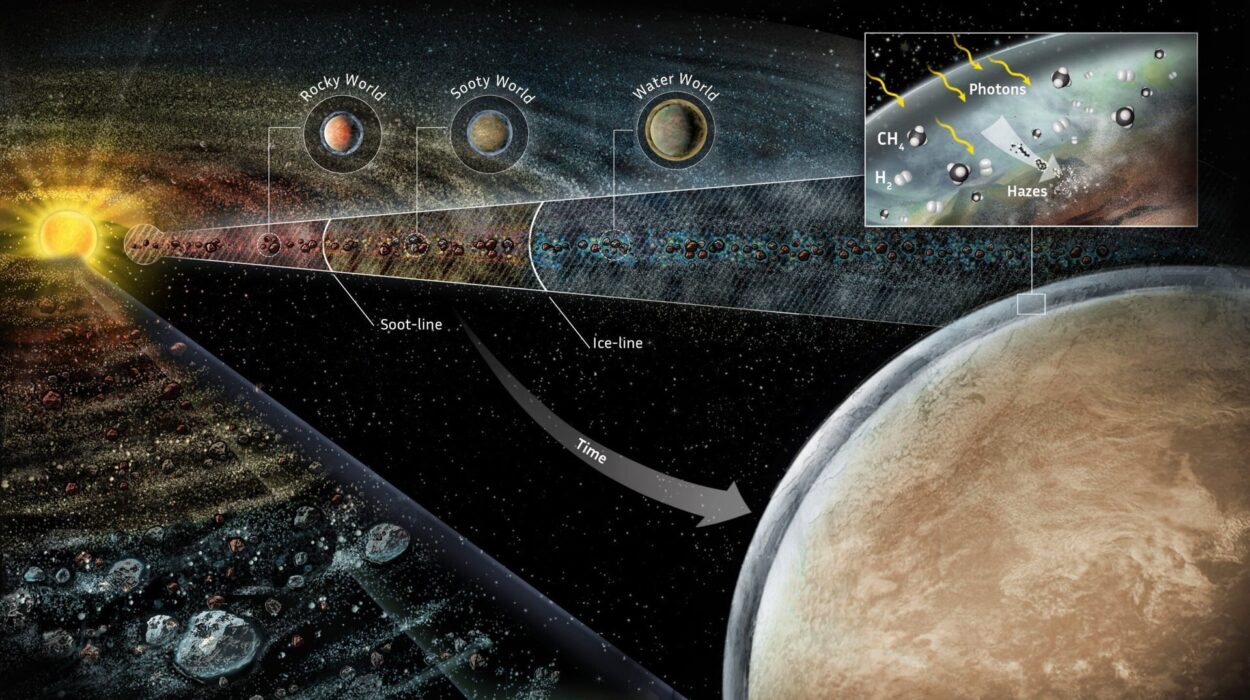Deep in the frigid expanse of the outer solar system, Saturn’s largest moon, Titan, cloaks itself in golden haze and mystery. Shrouded by a thick, smoggy atmosphere rich in nitrogen and methane, Titan has long been a world of intrigue—a frigid enigma echoing the dynamics of early Earth. But now, thanks to a breakthrough study led by researchers at the University of Bristol, one of Titan’s most elusive behaviors has come into sharper focus.
Titan’s atmosphere, as it turns out, is dancing to a rhythm all its own. It wobbles—gracefully, gyroscopically—not in lockstep with its solid surface, but swaying subtly through space, shifting with the seasons. This discovery is rewriting what scientists thought they knew about Titan’s climate system—and may even ripple into our understanding of Earth and other planetary bodies.
A World Apart, But Strangely Familiar
Titan isn’t just another moon. Larger than the planet Mercury, and the only moon in the solar system with a substantial, Earth-like atmosphere, Titan is often described as a primordial Earth in deep freeze. Its skies are thick and opaque, its surface dotted with lakes of liquid methane and ethane. The atmospheric pressure at Titan’s surface is comparable to Earth’s, but its average temperature hovers around -179°C.
For planetary scientists, Titan offers a tantalizing parallel—a glimpse at what our own planet might have looked like in its infancy. Yet for all of Titan’s familiarity, it refuses to be easily understood.
What makes this moon truly special is its complex, layered atmosphere. Unlike most moons, Titan’s atmosphere isn’t just a wisp of gas clinging to a rocky core—it’s dense, dynamic, and surprisingly active. Winds whip around the globe at breakneck speeds. Chemical reactions produce organic compounds that rain down like alien snow. And now, as the Bristol-led team has revealed, the entire atmosphere appears to wobble—tilting back and forth like a spinning top thrown slightly off balance.
The Long View: Thirteen Years of Cassini Data
The new findings stem from 13 years of data collected by NASA’s Cassini-Huygens mission, a collaborative endeavor involving NASA, the European Space Agency (ESA), and the Italian Space Agency. Cassini orbited Saturn from 2004 to 2017, making more than 100 flybys of Titan and giving humanity its most detailed look yet at this distant world.
By studying the thermal infrared emissions from Titan’s atmosphere—essentially, tracking how heat was radiating outward—scientists were able to build a long-term map of temperature patterns. These patterns allowed the researchers to trace the orientation of the atmosphere’s spin axis over time.
What they found defied expectations. Titan’s atmosphere wasn’t aligned precisely with the rotation axis of the moon itself. Instead, it was tilted. More surprisingly, this tilt wasn’t random—it followed a predictable seasonal pattern, and it persisted in a fixed direction in space.
A Planetary Gyroscope in the Skies
“The behavior of Titan’s atmospheric tilt is very strange,” said Dr. Lucy Wright, lead author of the study and a postdoctoral researcher at Bristol’s School of Earth Sciences. “It appears to be acting like a gyroscope, stabilizing itself even as the seasons change.”
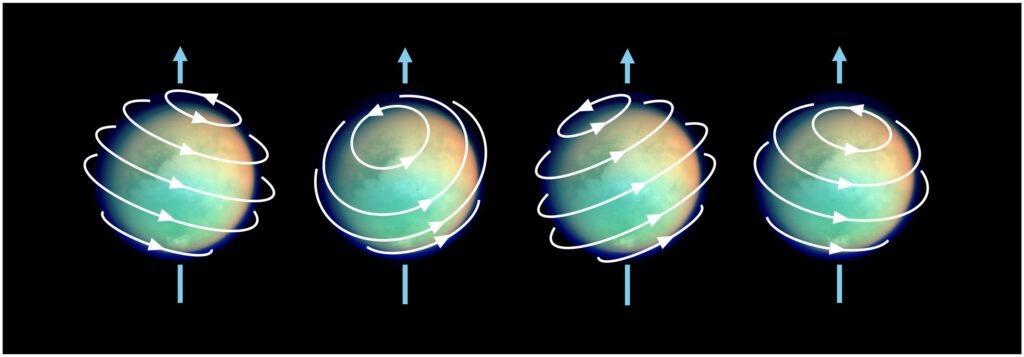
In simple terms, the entire atmosphere seems to be rotating around an axis slightly askew from Titan’s surface rotation. It’s not a drift caused by solar heating or Saturn’s gravitational tug, as scientists initially thought. Instead, the atmosphere appears to have been “knocked” into this tilted state by some unknown event—possibly an ancient climatic upheaval or internal dynamic—and it has remained that way, swaying rhythmically with Titan’s 29.5-Earth-year-long seasonal cycle.
This behavior is unique. Earth’s atmosphere, while influenced by seasons and rotational forces, is still largely locked to the planet’s axis. But on Titan, the atmospheric system seems to have gained a form of inertial independence—a spinning top whose motion isn’t fully dictated by the ground beneath it.
Fixed Tilt, New Mystery
One of the most surprising aspects of the discovery is that the direction of the tilt appears to be fixed relative to the stars, not aligned with the sun or Saturn. That finding raised eyebrows among the research team.
“What’s puzzling,” noted Professor Nick Teanby, co-author and planetary scientist at Bristol, “is how the tilt direction remains fixed in space, rather than being influenced by the sun or Saturn. That would’ve given us clues to the cause. Instead, we’ve got a new mystery on our hands.”
If the atmosphere’s tilt were being controlled by solar radiation (like Earth’s seasons) or Saturn’s tidal forces, it would shift accordingly. But the fact that the wobble holds its orientation suggests a deeper, more complex process is at play—possibly tied to Titan’s interior structure, polar vortices, or even unknown atmospheric feedback loops.
Titan’s Climate Engine: More Earth-Like Than Ever?
This atmospheric tilt adds a striking new dimension to our understanding of Titan’s climate engine. Already, Titan was known to exhibit Earth-like meteorological cycles—cloud formation, precipitation, and even surface erosion. Now, with the atmosphere behaving like a gyroscope, it joins Earth in showing large-scale seasonal asymmetries and global circulation systems that evolve over decades.
Interestingly, the tilt of the atmosphere may be influencing how Titan stores and releases energy. A slight misalignment in the temperature symmetry could drive hemispheric imbalances in wind strength, methane cloud formation, or even lake evaporation rates. Over the course of Titan’s long seasons, these subtle forces could reshape entire landscapes.
It also raises the question: what is the source of the energy sustaining this wobble? Is it stored angular momentum from past meteorological events? Or perhaps a form of resonance with Saturn’s tidal forces we have yet to detect?
Implications for NASA’s Dragonfly Mission
As esoteric as this discovery might seem, it carries significant implications for the future of space exploration. In the 2030s, NASA is set to launch Dragonfly, an ambitious rotorcraft drone designed to explore Titan’s surface from the air. With its ability to fly between geological sites, Dragonfly represents a new chapter in planetary exploration—part science lab, part aerial scout.
But Titan’s atmosphere isn’t just thick—it’s fast. Winds in the upper atmosphere can blow at over 400 kilometers per hour, nearly 20 times faster than the moon’s own surface rotation. Dragonfly will need to descend through this maelstrom, and understanding how the atmospheric tilt affects wind direction and strength is crucial for calculating its landing trajectory.
“The tilt affects how the payload will be carried through the air,” said Dr. Conor Nixon, planetary scientist at NASA Goddard and co-author of the study. “So this research can help engineers better predict where it will touch down.”
Cassini’s Legacy and the Archive That Keeps Giving
The fact that this discovery emerged from archival data is a testament to the enduring power of Cassini’s mission. The spacecraft, which plunged into Saturn’s atmosphere in 2017 in a planned finale, continues to yield scientific gold long after its demise.
“This instrument, partly built in the U.K., journeyed across the solar system and continues to give us valuable scientific returns,” Nixon added. “The fact that Titan’s atmosphere behaves like a spinning top disconnected from its surface raises fascinating questions—not just for Titan, but for understanding atmospheric physics more broadly, including on Earth.”
Indeed, while Earth’s atmosphere is deeply tied to solar heating and the planet’s axial tilt, Titan’s behavior shows that atmospheres can evolve on paths far different from our own. Could this kind of tilt occur on exoplanets with thick atmospheres? Might it affect the search for habitability? These are questions the new findings may help answer.
The Bigger Picture: Atmospheres as Independent Worlds
This study joins a growing body of research that suggests planetary atmospheres are not mere byproducts of planetary bodies—they are dynamic, independent systems that can develop their own momentum, feedback loops, and even histories. On Titan, the atmosphere seems to have “remembered” a past event that continues to influence its behavior today.
For Earth scientists, this is a provocative thought. What if our own atmosphere bears scars from ancient events still shaping today’s climate? Could Earth’s history hold hidden dynamical wobbles long forgotten?
Titan continues to be the solar system’s great paradox—so Earth-like, yet utterly alien. It hosts dunes shaped by methane winds, rainstorms of liquid hydrocarbons, and now, a gyroscopically wobbling sky. Each new discovery peels back a layer of its golden haze and reveals a world with not only its own chemistry and geology—but its own rules of motion.
As we prepare to return to Titan in the next decade, one thing is clear: this frozen, smoggy moon is far from static. It breathes, it shifts, and it wobbles. And in that wobble lies a story—a cosmic whisper—that scientists are only just beginning to hear.
Reference: Lucy Wright et al, Seasonal Evolution of Titan’s Stratospheric Tilt and Temperature Field at High Resolution from Cassini/CIRS, The Planetary Science Journal (2025). DOI: 10.3847/PSJ/adcab3
